This post by Leapfrog expert Ron Reid discusses TOP 5 reasons why Leapfrog Mining continues to be the better Leapfrog software for most mining and exploration related work a full two years after Leapfrog Geo was released to the market. I will be outlining some specific reasons why these original features of Leapfrog Mining were developed and how they are actually used in real projects in future blog posts, so please register with us, make comments on our posts and check for updates. - Jun Cowan.
---
I am a firm believer in sending comments back to the developer to ensure the package you use is as good as it can be. If you have bugs or dislikes with the software program you use then chances are there are others who have the same. If you do not tell the developer they will either not be aware of the issue, or not have a sufficient number of complaints to ensure developer time can be devoted to the issue. Many times I have heard that a user hates how their software does something but when asked if they have provided feed back to the developer they often say "No". I have even heard several people raise the same complaint regarding another program and none had sent the complaint in, as they all assumed someone else would have already done it. Indeed they might have but perhaps not enough have done so to ensure the minimum quota of complaints were received to ensure the issue is fixed.
Over the past two years I have used Leapfrog Geo intermittently in an effort to learn and understand the new workflows and enable me to offer constructive criticism and advice to ARANZ Geo about the program from my perspective. I have just recently completed a significant structural and geological model for the company that has involved several field visits for mapping and core logging and many hours building the model in Leapfrog, ensuring the relationships in the model match what we see in the field. For the first time I devoted myself full time to Geo from start to finish rather than cheating by running two parallel projects and moving data between the two. What better way of ensuring I have an understanding of Geo, its benefits and its negatives.
My perspective may be similar to thousands or completely unique – either way notifying ARANZ of my thoughts on the software adds another voice to the list and hopefully will help result in a better program. My thoughts below have been communicated to ARANZ and so they are aware of these issues – if anyone agrees please send in your comments, below (by registering with this Orefind website first). At the end of the day we all want the same thing and that is a comprehensive program that is a pleasure to use.
Before I get to the nitty gritty of Geo I want to mention in passing the mental gymnastics that must be accomplished in order for me to go from Leapfrog Mining to Leapfrog Geo.
Leapfrog Mining is a tool box that works in volumes. You are dealing with the volumes in space as defined by the RBF rather than the surfaces and meshes created as an output. The meshes are a secondary consideration and I commonly delete them from my Leapfrog Mining projects because they just take up good memory for no particular reason. Building a model in Leapfrog Mining involves carving up lumps of space in 3D.
Leapfrog Geo is the opposite of this. It relies on the surface output – you sculpt the mesh or surface and use this to build your final product. For me this is a major hurdle, whilst I can see in my mind’s eye the final product I want to achieve I have trouble working out how I can create it using the multiple surfaces I see in front of me rather than simply combining and filtering a couple of RBF volume models. To do things the Geo way when coming from a long history of Leapfrog Mining is a significant jump and one that many long-time Mining users have a hard time doing.
With that out of the way I can get to the point –
the five most annoying things in Leapfrog Geo that ensure I will be continuing to use Leapfrog Mining for the bulk of my work. I list these in increasing order of annoyance, so we start with the least annoying first with Number 5.
Number 5: The massive defaults on ribbons, disks and points
Whenever you turn on the points in Leapfrog Mining, or the normal ribbons, or display some structural disks for the first time you always get something realistic like 20m wide ribbons or 15m wide disks. You turn on the 3D point mode and get something that is close to the size of the non-3D points. In Leapfrog Geo when you turn on the ribbon you get something that is 10 km in size, structural disks that are 50 km across – all very well I guess if you are modelling New Zealand but a bit excessive when modelling a 600x800m deposit. Turn on 3D points and you can get points 10,000m across – try telling your video card to process that promptly when you have 200,000 samples. Perhaps a bug as I can’t fathom why it would be built that way but why would that get past the QAQC procedures – but then perhaps my version is unique!
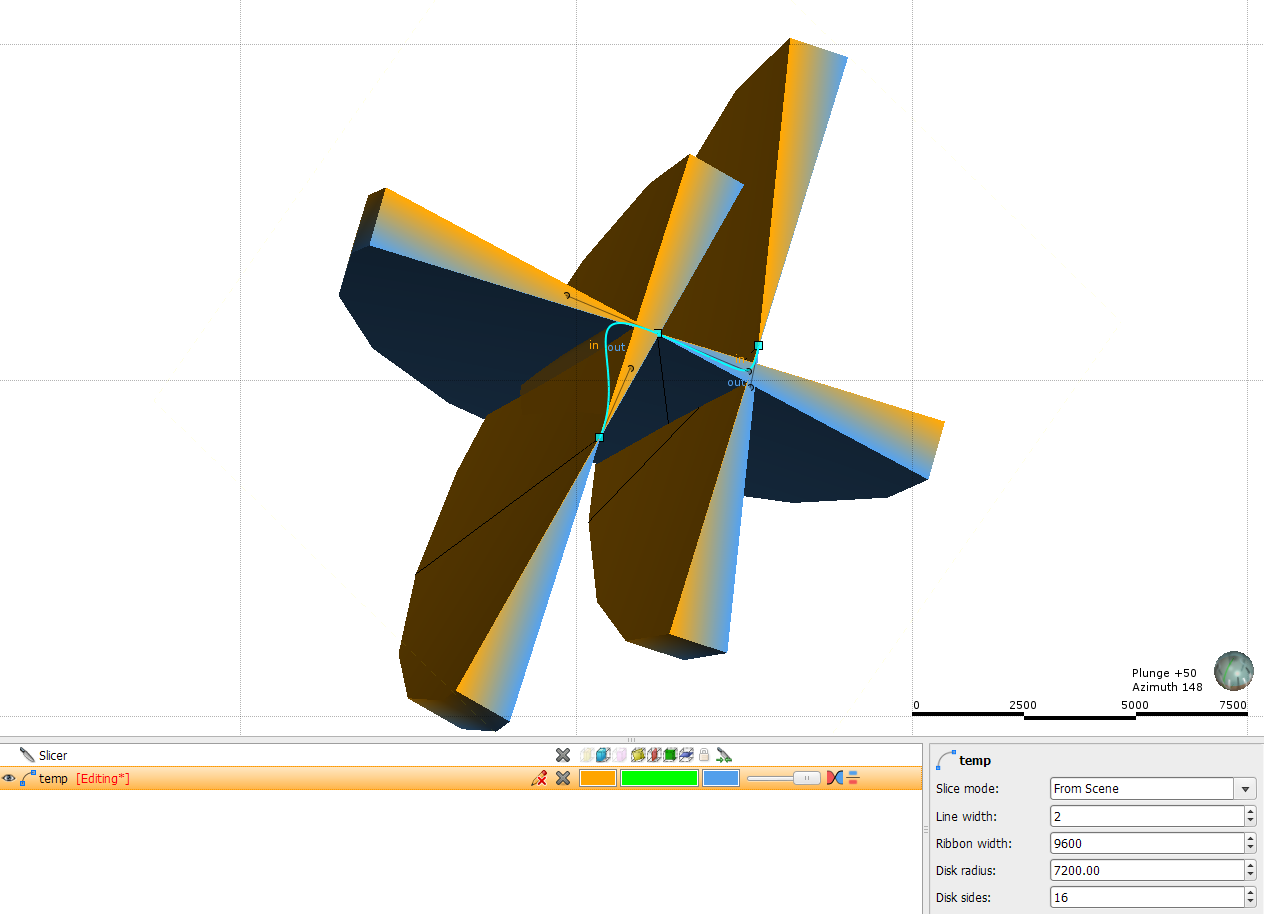 An example of the super-sized default ribbons and radius.
An example of the super-sized default ribbons and radius.
Number 4: The Moving Plane
In Leapfrog Mining the Moving Plane works in User Coordinates which basically means it works relative to the computer screen (ie. relative to the view line). When you move the Moving Plane it moves in a plane parallel to the screen coordinates. If you want to move north – south you look down, North – Elevation, look west, in the plane normal to the plunge you look down the plunge (Ctrl+M) and then you can move it around in that plane. Geo however has changed this behaviour and now it only moves in World Coordinates, which is relative to the coordinates of your data. You can only move your plane in a North-East-Elevation manner using the handles on the plane. This makes it near impossible to move your plane relative to the plunge, you need to move it a little bit south, a little bit west, a little bit up, a little bit north etc, else you are constantly re-drawing the moving plane and manually enter the numbers to ensure consistency. You can see how this restriction can be irksome to the ability to rapidly shift the moving plane to assess the data. Please bring back the Leapfrog Mining Moving Plane!!
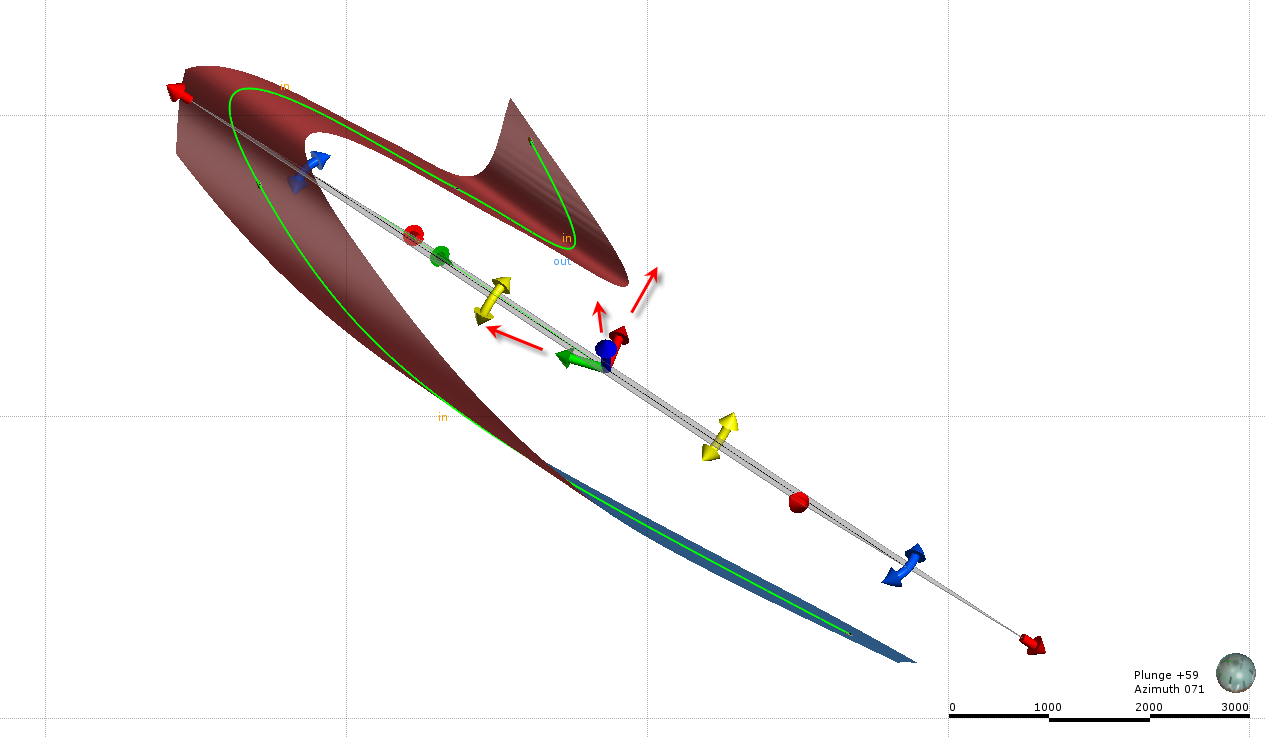 The Moving Plane in Leapfrog Geo can only move in geographic coordinates using the handles at the centre which places a real restriction on usability. This renders the Moving Plane virtually useless unless you are working in the World Coordinates but most deposits are not parallel to the World Coordinates.
The Moving Plane in Leapfrog Geo can only move in geographic coordinates using the handles at the centre which places a real restriction on usability. This renders the Moving Plane virtually useless unless you are working in the World Coordinates but most deposits are not parallel to the World Coordinates.
Number 3: The loss of combined interpolant models
Working with a lot of multi-element projects it is quite common for me to be asked where the high value versus low value parts of the project are or what various elemental ratios are doing across the deposit. With the Leapfrog Mining Combined Interpolants module I have a unique way of combining the interpolants of say copper and gold, or gold and silver, or copper and gold and moly, and then creating some arbitrary shells of the results. The specific values of the shells are not meaningful in themselves although if you put in the time and effort to work out the value of each element as a proportion of one you can closely approximate the reality. This is a very rapid way of explaining where the value is in a project is and where additional drilling is likely to give you the most bang for your buck without the hassle of going outside Leapfrog and calculating it all in a spreadsheet and bringing it back in. Combining interpolants is also a fantastic way creating a medial plane between a hangingwall and footwall of a vein or fault. In Geo combining interpolants is no longer possible, instead you combine models which are basically a series of simple Boolean operations. A process which in its own right does a lot that is useful but is not the same thing as combining interpolants. Please bring back the combine interpolants module!
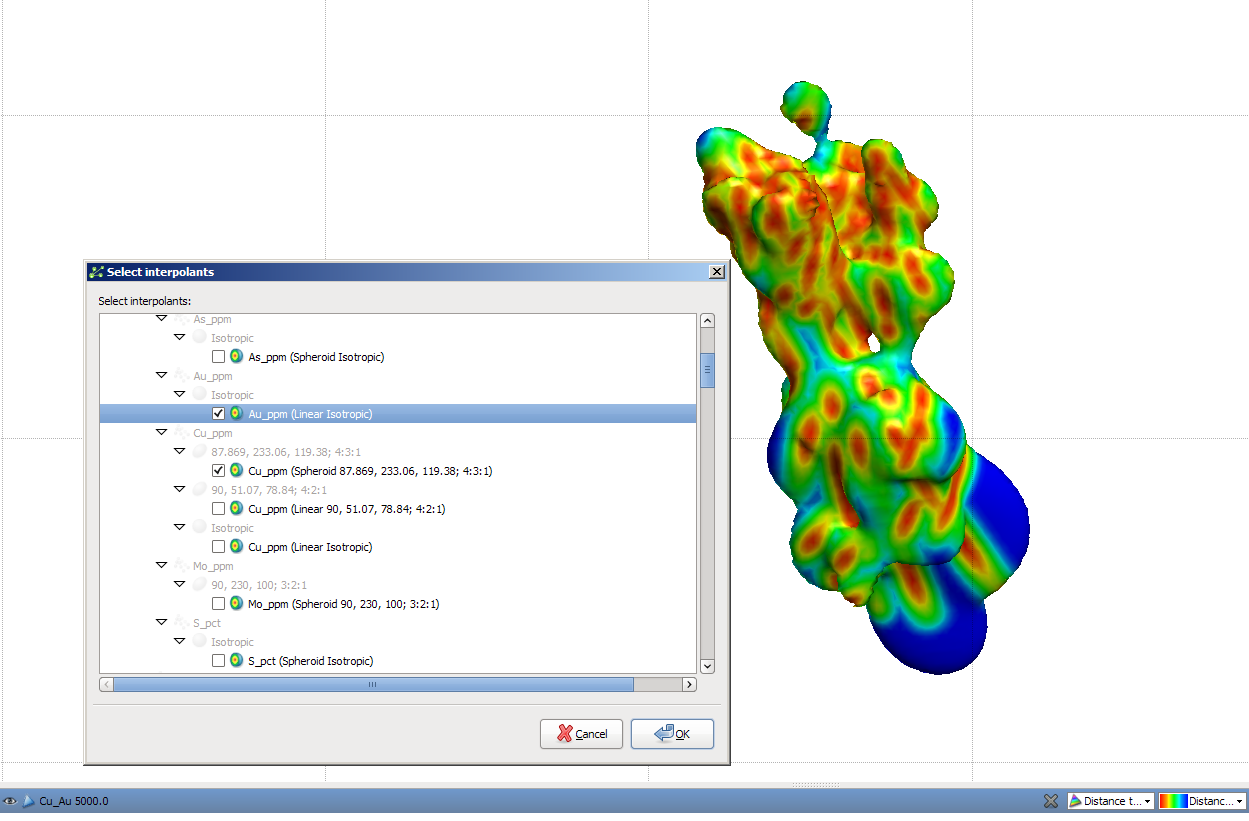 The combined interpolants are useful for showing those areas of the orebody that contain the value – here I have a high value copper gold shell coloured by distance to drilling – you can see those areas lacking data!
The combined interpolants are useful for showing those areas of the orebody that contain the value – here I have a high value copper gold shell coloured by distance to drilling – you can see those areas lacking data!
Number 2: The curved polyline
The polyline tool in Mining is a marvel to use and a major breath of fresh air in the mining arena. Richard Lane is to be congratulated for bring this process out of the 2D drawing field and into 3D. The ability to simply digitise a line in section or snap to meshes, create the curves using the Bézier mode and know that all the normals conform to the current view rapidly speeds up the workflow. If you need to re-orient the normal you could simple click on a point, a segment or double click for the whole line and select the align tool. See Jun’s previous posts on the development of the tool
here and
here for a more in depth discussion of the tool. It truly is a great tool and once you have the hang of it the speed with which you can use the tool significantly increases your productivity. In Leapfrog Geo however ARANZ have managed to mangle it. In the early versions they removed curved polylines altogether which thankfully they corrected. But when it was brought back it was different. No longer is it the simple multipurpose tool available in Leapfrog Mining.
You have a tool split into a segment tool where the normals cannot be easily altered once the line has been created but which can snap to meshes, and a curved polyline tool that has no normals and cannot snap to meshes. To add normals to the curved polyline you must first complete the line, double click and then select the add structural disks option.
This process turns what was 3 clicks (click-drag, click-drag, rightclick-end) to create curved surface to 6 (click-drag, click-drag, rightclick-end, double click, click add structural disks) – an effective doubling of work.
And don’t get me started on how many times I have had to go back because I forgot to add the normals! I have heard that ARANZ are making changes to the curved polyline tool such as the ability to snap to meshes – please go further than that and simply bring back the Leapfrog Mining drawing tool!
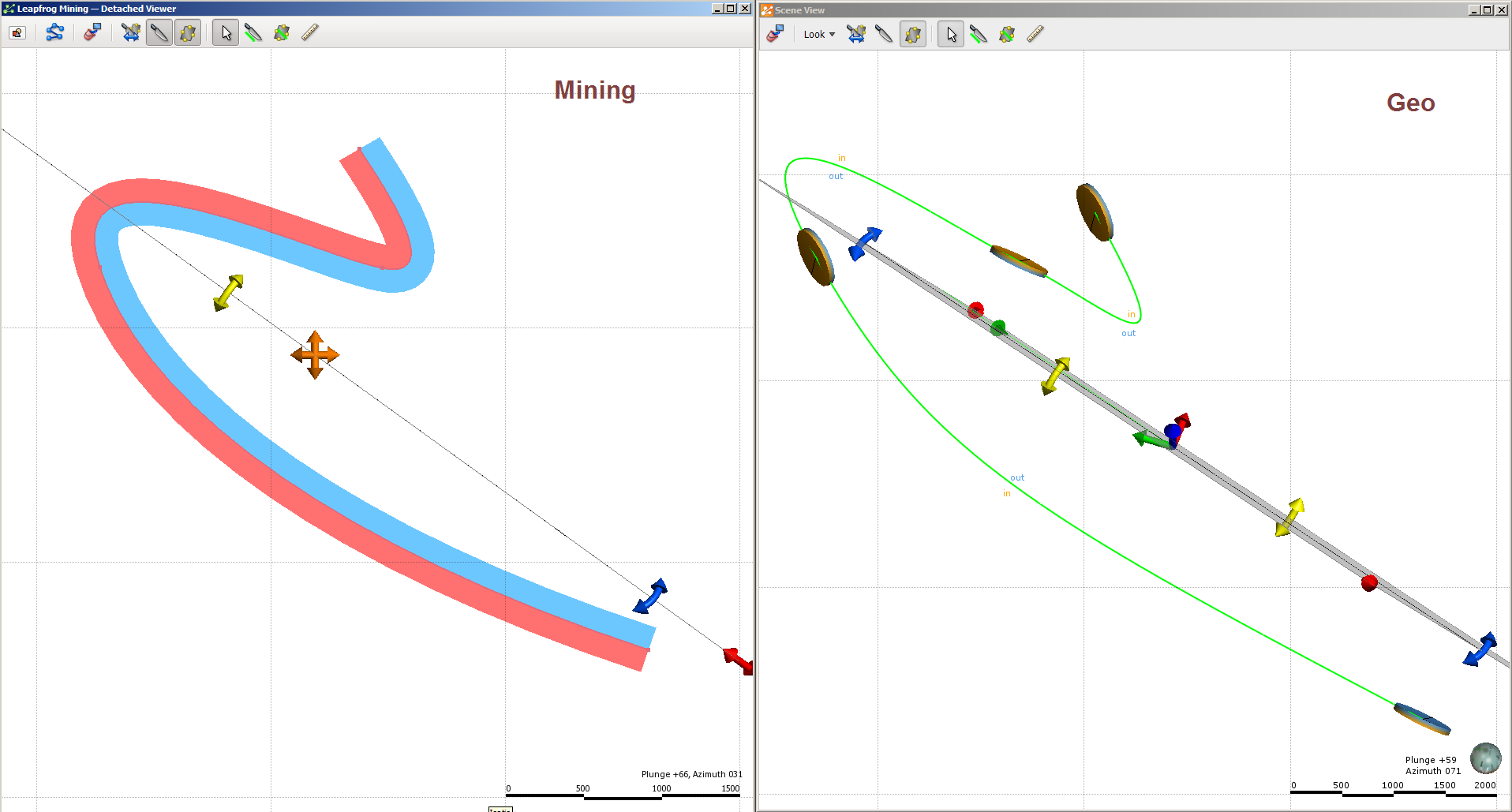 The difference between the Leapfrog Mining polyline tool and the Leapfrog Geo tool. The mining tool is a lot more usable and manipulative.
The difference between the Leapfrog Mining polyline tool and the Leapfrog Geo tool. The mining tool is a lot more usable and manipulative.
Number 1: The loss of the ability to query interpolants and the domaining workflow.
And finally
my number one gripe is the loss of the ability to query the interpolants. In much of my work I do not create geological models (ie. wireframe models), rather I am dealing with orebodies, metal distribution, mineral species distribution and metal ratios. In Leapfrog Mining when asked where the high grade copper sits relative to the 2% chalcopyrite distribution within the porphyry it is very easy to create a domain based on the porphyry, a grade cut-off and a chalcopyrite shell. Because I can query the interpolants and I am dealing in 3D space then this becomes a simple statement problem where I create a domain based on the interpolants where ‘porphyry’ is positive, ‘cu_ppm’ > cut-off and ‘chalcopyrite’ > 2, a very simple process that involves very little mental gymnastics. If I get hit with a question like “what about outside the porphyry” I simply change the positive to negative on the porphyry interpolant. When dealing with domains I can be dealing with anything – a rocktype, a grade cut-off, an alteration type or a mineralogical shell.
The terminology is simple and the ability to add and remove various elements is also simple. If I want to create a model split by an oxidation front I simply create a domain where base of oxidation is positive and create the compliment for the negative “non-oxide” material.
In Leapfrog Geo however we are forced to deal with the geology modelling workflow and as we use meshes we cannot query the interpolants. To do the above I am required to ensure I have all the relevant meshes and if not build a specific interpolant shell of the chalcopyrite, a specific interpolant shell of the grade, a geological model based on the porphyry. Then I must use combined models to create the final combined meshes, then realise it is not what I want once the processing has finished and try again, and the issue might link right back to one of the original meshes taking some time to track down.
If I am required to generate an alteration domain (say an advanced argillic alteration) I am required to model it as an intrusion within the geology model which is simply counter intuitive. If I want to split my model on an oxidation front I have to model it as a fault (and that is not very intuitive either!) – or create 2 models with the oxidation front used as a boundary.
The Leapfrog Geo Model workflow is only intuitive if you are specifically building a stratigraphic geology model.
Anything else and you are required to shoehorn your modelling process into the rigid Leapfrog Geo workflow and sometimes the adapted workflow is not intuitive – like using the fault option to create an oxide horizon – something that from a mineral processing point of view is very important.
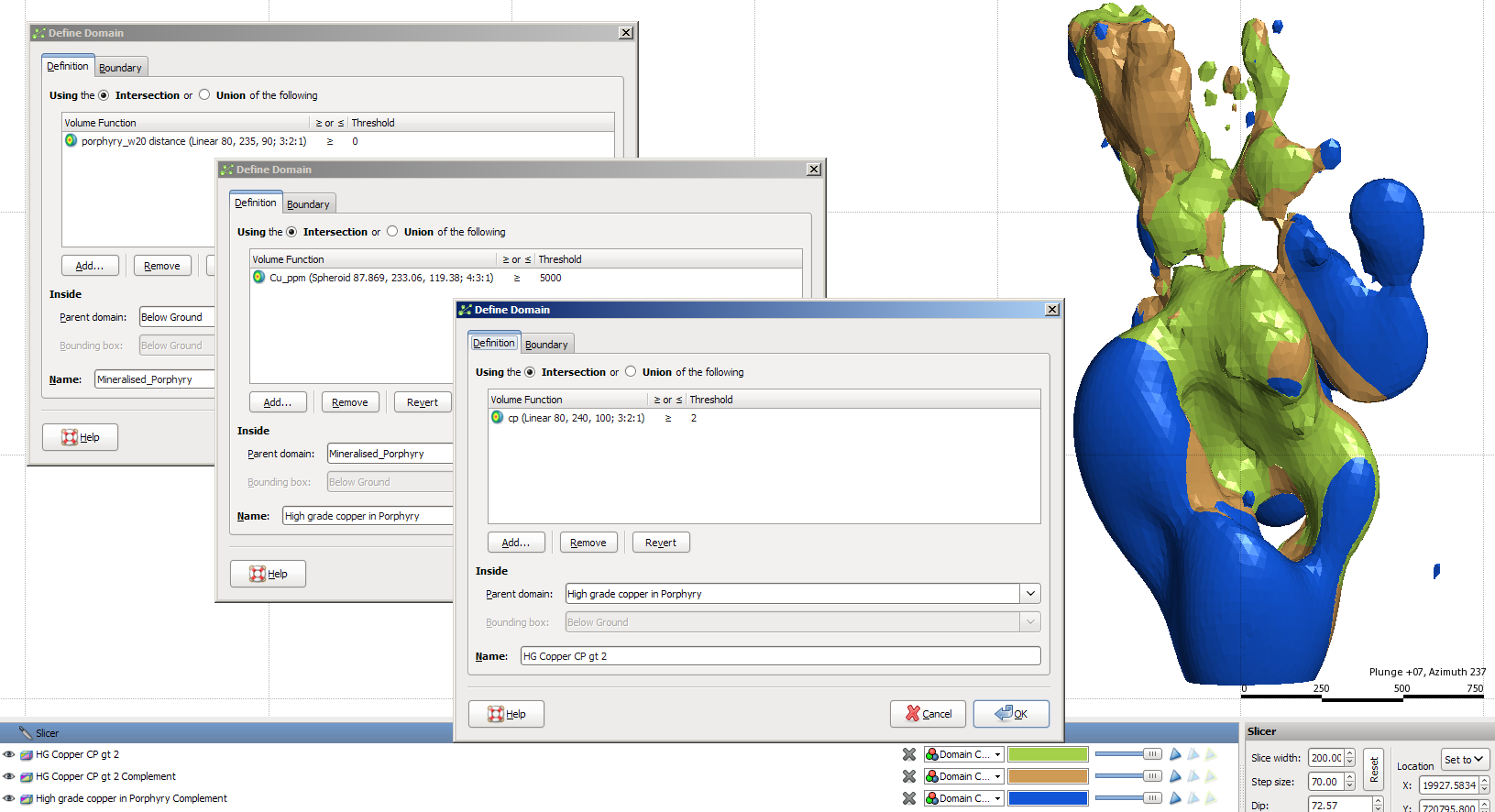 Creating grade domains by querying the interpolant – not a geology model in sight, for a specific task I could combine all these into one domain form and just obtain the portion I am after however stepped out like this makes it easier to change individual parts and assess the compliments.
Creating grade domains by querying the interpolant – not a geology model in sight, for a specific task I could combine all these into one domain form and just obtain the portion I am after however stepped out like this makes it easier to change individual parts and assess the compliments.
So there you have it – the five reasons I will continue to use Leapfrog Mining. Leapfrog Geo is a good product and once I got my head around the workflow and looked at how I could accomplish what I needed it was capable of generating most things I do on a day to day basis – but for most tasks it was neither intuitive nor simple.
For many tasks as far as time to complete and number of clicks, it involved more steps and more clicks to accomplish the same result as Leapfrog Mining. It has some redeeming features and helpful improvements that unfortunately Leapfrog Mining is destined never to get but in reality the whole program is simply a module of Leapfrog Mining. An add-on if you will that you might jump to when creating a specific type of model but over all just another tool in Leapfrog Mining’s tool box.
Oh, and one more thing...
There is one last comment I would like to add, the most significant, painful, exasperating change is the movement of the clear screen button in Leapfrog Geo so that it occupies the same location as the save scene button in LeapfrogMining.
Whoever made this decision needs to be hung, drawn and quartered, and have their bones ground and dispersed to the four corners of the earth! From this (Mining);  To this (Geo);
To this (Geo); 
Happy modelling (unless you are the person for the above decision…).
Ron.